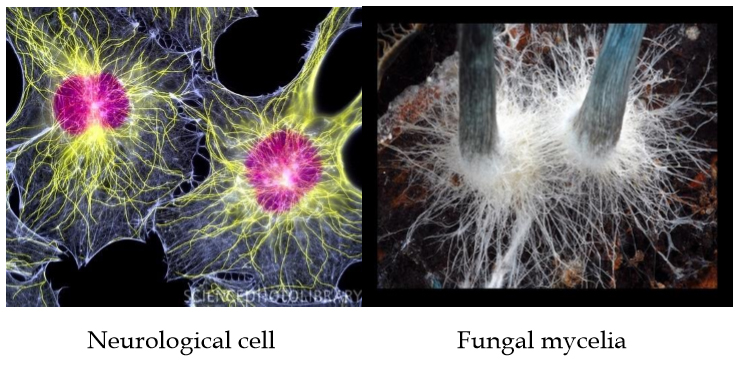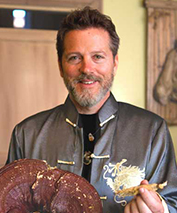




Reishi is a tree fungus that is highly revered throughout the history of Asian herbalism. The Japanese name, reishi, is most commonly used. In China it is called lingzhi, and the Vietnamese name is linh chi; all of which mean “soul/spirit mushroom” or “supernatural mushroom.” Reishi is said to support a long, vibrant and beneficial life, and has earned the titles “mushroom of spiritual immortality,” and “good luck herb.” Its Western pharmaceutical name is Ganoderma lucidum, so named for its shiny upper surface.
Reishi is a member of a class of tree mushrooms called Polypores, due to their fine porous bottom surface, as opposed to the gilled underside of most common and edible mushrooms. Polypore mushrooms grow in forests on dead wood. Hi quality semi-wild ganoderma is grown outside on cut logs, and commercial varieties are cultivated in controlled environments on moistened rice, oats, hay, and other substrates, with varying degrees of quality. [1] Polypore mushrooms are generally not edible, as the cellulose is tough and fibrous, with a lignin structural matrix similar to cork wood. The fruiting body and mycelia are used to create reishi products, but the fruiting body is thought to be the most valuable part for health. Cracked spore and spore oil products are recently available, but I believe breaking the spore cell wall is destructive to reishi’s natural design and intention.
Polypore mushrooms include varieties of reishi that vary in color, and its many cousins (ex. Ganoderma Oregonese), chaga (Inonotus obliquus), maitake (Grifola fronderosa), Phellinus lintaeus and turkey tail (Coriolus versicolor). These mushrooms are found growing in many regions, with ganoderma varieties occurring almost universally around the world.
Many studies have proven the effectiveness of polypores for supporting general immunity, [2] but reishi is also said to enhance spiritual perception. This illustrious reputation was cultivated over thousands of years of experiential observation, and a great deal of Asian art and literature has documented reishi as a spiritual herb, although modern scientific analysis has not developed the mechanisms to evaluate these properties.
Ancient Chinese folklore attests that one who takes reishi can attain immortality, and that regular consumption can “initiate benevolent cycles of health.” My favorite saying is that reishi is a “bridge between Heaven and Earth.” We can view this in the scroll painting below.

In the lower portion, people are dwelling on Earth, sipping tea and walking in the forests. The venerable Lao Tzu leads a group of young scholars. Quan Yin ponders harmony in natural beauty, and young lovers revel under the trees. In the center, a reishi mushroom grows on a rock, and above, the Emperor and Empress dwell in the Imperial Palace and ascended Immortals ride celestial dragons among the clouds. Reishi is said to imbue immortality when taken regularly. “Celestial Immortals” have been described throughout Chinese literary history. Many of these Immortals are still said to dwell in the high realms of China’s five sacred mountains. The Queen Mother of the West, China’s Matriarch, lives atop Kunlun Mountain and holds a reishi mushroom in her lap. Historically, writings in the Shennong Bencao, possibly dating to 5975 B.P (before present) state that reishi can “prolong life so as to make one an immortal.” Ge Hong (1734 B.P.) created an elixir with gold reishi that was sought after by Emperors. He stated that reishi could pertain to “an intermediate dimension between mundane and transcendent reality,” and that the mushroom could “produce geniehood.” Li Shizhen (437 B.P.) stated that it could “lengthen life to that of the Immortal fairies.”
Since discovering reishi, I have sought to decipher the possible biochemical pathways responsible for its purported spiritual enhancement and its ability to support long life. I began with the impressive modern research on reishi’s immune-supporting potential. Analysis reveals polypores contain a class of powerful polysaccharides called Beta 1-3-6 glucans, which are found to activate cytokines, special enzymes that penetrate and invigorate white blood cells, or macrophages ~ our body’s primary immune defense agents. When macrophages are empowered, the immune system will be engaged in cellular protection from anti-microbial activity through phagocytizing and general blood cleansing. Reishi also contains organic germanium (up to 6000 pts. Per mil.), and is high in triterpenes, also called ganodermic acids, which comprise the bitter component and are measureable as the therapeutic biomarker [3] (bitter is better).
When the body’s internal defenses are strong, we feel safer and protected, which relieves the adrenals of stress from worry and insecurity. When empowered, we are confident and willing to engage in life’s adventures. This optimistic attitude can brighten one’s light. Confident people will attract many friends and admirers, and in time, we become “The Light,” inspiring those around us. We then find we can help people, and we receive help. Thus, we unveil the “benevolent cycles of health” mentioned before.
This represents a potential psycho-somatic side benefit of taking reishi, but, mushrooms are also known to affect the psyche and perception in ways that aren’t yet scientifically documented. Reishi does not induce psychotropic experiences, but it appears to expand perception. So, let me attempt to explain some possibilities for this potential, as well as delve into many mysteries around the origins of life on Earth and the role advanced fungi may play in consciousness.
Some revelations may exist in the study of Astrobiology. Many Mycologists believe that mushrooms are extra-terrestrial life forms, due to their taxonomic sovereignty, and because fungal spores are capable of surviving space travel; mushroom spores are microscopic and light enough to drift out of our atmosphere and into space (gravitropism), potentially making Earth a cosmic fungal sporulation lab (the spores are initially launched from the fruiting body cells through ballasting processes that may involve diamagnetic electrostatic repulsion, propelling them high enough into the air to be caught in wind currents).[4]
Beginning in the 1970’s, Astrobiologists proposed that basic archaea and much prokaryotic (single celled) life is extra-terrestrial, having originally blown into our atmosphere or arrived in blocks of ice and on meteorites.[5] In the case of the mysterious red rain of Kerala, scientists discovered the tinting was caused by moisture capturing an extraterrestrial algae that was drifting into Earth’s atmosphere. The event was preceded by a sonic boom that may have been from a meteorite that entered our outer atmosphere and exploded, dispersing the algae.[6] Such microbes are called extremophiles, due to their resilience under heat, cold and pressure. Extremophilic organisms are now thought to be responsible for seeding planets with biologically active life.
During Earth’s early stages, it is thought that bacteria sought refuge from solar radiation inside the permeable fat walls of algae cells, forming colonies that eventually created cooperative intercellular organelles and mitochondria, leading to the rise of complex multi-cellular (Eukaryotic) life. [7] I discussed in my book Threshold to the 4th Chakra that it is unlikely that bacteria alone created these cellular components. Bacteria remain in their own kingdom and perform many symbiotic actions within their milieu, but they do not become functioning DNA of larger organisms. These scientists overlook another important kingdom responsible for the rise of complex life; fungi may have supported the development of microtubules of cellular cytoplasm ~ the information transport system of the cell. By this, I believe that bacteria, algae and fungi combine to create higher life forms.
Fossils reveal that Earth’s earliest masses of carbon material, called stromatolites, were composed of lasagna-like layers of algae and bacteria, enabling nitrogen fixing, molybdenum oxidation and other important components for life. As this material decomposed, “carbon substrates” formed, creating a medium conducive to fungal sporulation, and tiny filaments of mycelia permeated the substrates, creating nutrient-delivery systems that were remote, thus introducing the conscious transfer of information. I believe that without fungal mycelia, life would merely be composed of tiny organisms living and dying to create sandwiched mounds of matter. While bacteria and algae do function consciously, they would have continued within this cooperative environment into perpetuity. It wasn’t until mycelinating fungi created neurologic systems that symbiotic multicellular life with higher consciousness evolved.
Cytoplasm in eukaryotic cells has no physical similarities to colonized bacteria, but does resemble fungal mycelia in structure and function. In fact, they can hardly be distinguished, as revealed in the images below. On left is a Human neurological cell and right is fungal mycelia. Both are information-transport networks.

And now, for the mystery question; if fungi, bacteria and algae combined to create higher conscious life, when and where did this original evolution take place? If these microbes, archaea, diatoms and spores have been transported to Earth over potentially vast distances and time-travel, then where did they come from? The only answer we can assume is: everywhere.
Earth’s oldest rock samples (approx. 3.5 billion years B.P.) contain fossilized cyano-bacteria (algae-mimicking bacteria).8 This indicates they evolved somewhere long before Earth’s atmosphere was established. These considerations imply that Earthly life follows a pre-established order that is symbiotic with all life in the cosmos, and indicates a universal Blueprint. Every celestial body in the universe may be dusted with bacteria, algae and spores, and, depending on a planet’s proximity to a star, they will begin a long process of creating and regulating an atmosphere conducive for life, where evolutionary patterns will progress to create environments and organisms that share common biology with our planet.
Then again, we must ask, where did all this begin? We can only humble ourselves in the face of this mystery, but we can also know that there are worlds beyond - before and after, for, if these lifeforms arrived on early Earth, they must have evolved on planets identical to ours. As mentioned, bacteria are functional symbionts of biological activity; algae create oxygen atmospheres, which, along with bacteria can congeal to create carbon substrates, but the advanced fungi appear to be the harbingers of consciousness, allowing organisms to cooperate and contemplate life, and by which Humans might even someday discover and communicate with life on other worlds.
We have long known that mushrooms benevolently affect consciousness. Reishi is not psychotropic and does not alter perception, but benefits mental clarity and helps instill a reverent attitude. Reishi enhances spiritual enlightenment, and seems to “weave us into the mycelial web of life.” The subterranean relationship of fungi with plants is called mycorrhiza. Humans attempted to sever ourselves from this relationship through disassociation with the ground (pavement, shoes, tires, etc.). Protracted taking of reishi appears to resuscitate our connection to everything else; plugging us back into our Earth. Nature is calling us to reunite for common survival, and that is why I believe reishi and other tonic herbs and superfoods are emerging in our consciousness that this time.
It is relatively simple to create and maintain the microenvironments and conditions for growing our own reishi, therefore, it cannot be controlled, usurped, sequestered or denied from us. Wild reishi is a world-wide phenomenon that could never be exhausted or endangered, therefore, we all have access to this lifechanging messenger. By taking reishi, we could quickly experience the rapid unfoldment of our higher stage of evolution, which could metaphorically correlate with the 4th Chakra energy of the Heart - the energy of giving. Of reishi’s five colors, the red reishi is associated with the Heart. Curiously this is the variety that is revealing itself to us as we walk in the woods, and is even seen growing on trees in city streets.
The timing is impeccable for our advent into a higher phase of evolution, as Earth will not continue to provide the seemingly inexhaustible resources we have been used to consuming. Now, as we take reishi, we understand our destiny as propagators and managers of life on Earth rather than simple usurpers and consumers. In our pending advanced evolutionary phase, we begin replenishing the fruits of Mother Earth. We will be required to redirect the majority of our activities to collective remediation of nature. Our unfolding awareness of reishi carries the messages of this new empowerment. After twenty years of personal use and observation, I believe that taking reishi, along with other tonic herbs and a wholesome living-food diet will provide the accelerated progression of our evolution into caring beings that live symbiotically with our planet. As more people take reishi, we may quickly and effectively adapt to and apply the changes that are immanent, and the Human race and our world will be healed and preserved.

Rehmannia is a Taoist Tonic Herbalist in the Gate of Life lineage, a 5000 year old herbal system from China. In 1998, he met Master herbalist Ron Teeguarden and became his personal apprentice until 2006, when he formed Shamanshack. Rehmannia studied Chinese medical diagnosis at Alhambra University, and obtained a degree from Natural healing College as "Master herbalist", but adheres to the title master Teeguarden gave him as "Superior herbalist." He is a pending member of the American herbalists Guild.
Rehmannia is adept in the 5000 year old healing discipline called the Gate of Life lineage, which utilizes "Tonic" herbs to maintain balanced health. He has written 5 books including Raw Chi, Healing Thresholds and The Hsien, and is near completion of an online course in Taoist health philosophy and Tonic herbalism in the Gate of Life lineage (www.GateofLife.org).
Rehmannia created all Shaman Shack products, and sources only the highest quality herbs. He is truly a front-runner in his field, and has taught and influenced many mendicants of Tonic herbalism.
Website: www.ShamanShackHerbs.com
Shaman Shack Herbs offers high quality 10:1 extracts of the Reishi fruiting body only.